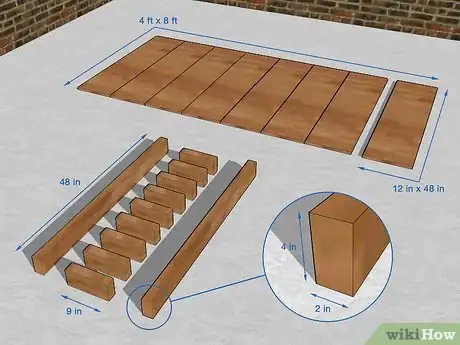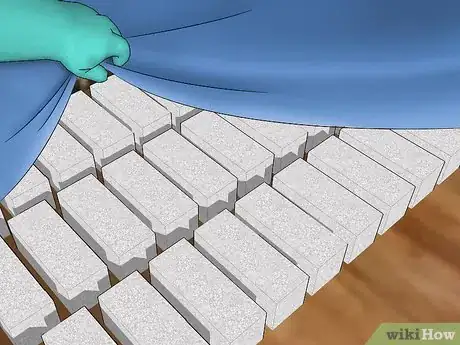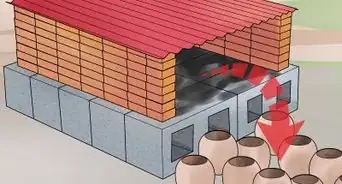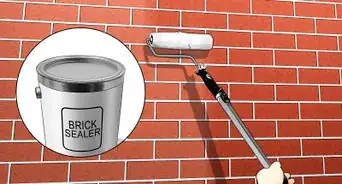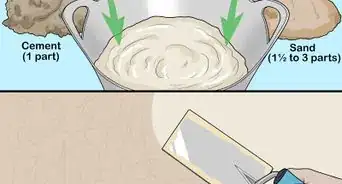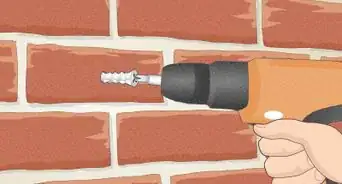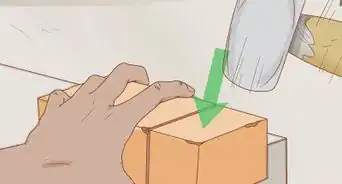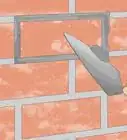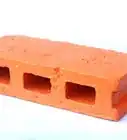This article was co-authored by Gerber Ortiz-Vega. Gerber Ortiz-Vega is a Masonry Specialist and the Founder of GO Masonry LLC, a masonry company based in Northern Virginia. Gerber specializes in providing brick and stone laying services, concrete installations, and masonry repairs. Gerber has over four years of experience running GO Masonry and over ten years of general masonry work experience. He earned a BA in Marketing from the University of Mary Washington in 2017.
wikiHow marks an article as reader-approved once it receives enough positive feedback. In this case, 91% of readers who voted found the article helpful, earning it our reader-approved status.
This article has been viewed 445,398 times.
Bricks have been primarily used for wall coverings over the years, but they can be used for decorative purposes as well. Historically, the common brick has been molded from clay and fired in a kiln, but you can make bricks yourself by using concrete.
Steps
Making Brick from Concrete
-
1Make the forms you need to use for the concrete bricks. This requires basic carpenter tools and a sheet of .75-inch (19 mm) plywood along with 2 x 4-inch (5.1 x 10.2 cm) by 8 feet (2.4 m) lumber. Use 9 x 4 x 3.5 inches (22.9 x 10.2 x 8.9 cm) for your brick dimensions.[1]
- Rip the sheet of 3/4 inch plywood down to 12-inch (30.5 cm) wide x 48-inch (1.2 m) long strips. This will give you 8 bricks per strip, and the entire sheet of plywood will give you a total of 64 bricks.
- Cut the side forms down to 2 x 4 inches (5.1 x 10.2 cm). You will need 2 pieces at 48 inches (1.2 m) long for each strip. There will be 9 pieces, 9 inches (22.9 cm) in length.
-
2Assemble the forms with the two 48 inch (1.2 m) pieces laid parallel. Begin nailing the 9-inch (22.9 cm) pieces between the two 48-inch (1.2 M) strips using either double-headed 16 penny concrete form nails or 3-inch (7.65 cm) deck screws. When finished, you should have 8 spaces 4 inches (5.1cm) wide, 9 inches (22.9 cm) long, and 3.5 inches (8.9 cm) deep.
- Lay the strips of plywood on a flat level area and spread plastic sheeting over it to keep the concrete from bonding with the plastic. The work area will need to be left undisturbed for at least 24 hours.
- Place the assembled side form on top of the .75-inch (19 cm) plastic covered plywood strip. Either nail the side forms to the plywood or drive wooden stakes around the sides of the forms to keep the forms from shifting off of the plywood bottom strips.
- You can use screws for easier removal, if desired.
Advertisement -
3Use a spray can of form release oil to aid in stripping the forms after pouring the concrete into the brick molds.[2]
- Take care not to stain any concrete bricks.
Making and Pouring the Concrete into the Brick Molds
-
1Make the concrete and pour it into the assembled molds. This will most likely be the most physically challenging part of making brick from concrete. Using a commercially prepared dry mix of concrete materials is the easiest method. It is often referred to as Sak-crete and normally comes in 40-to-80-pound (18.1-to-36.2 kg) bags, which are then mixed in a wheelbarrow.
-
2Put a bag of prepared concrete material in a wheelbarrow. Make a small hole in the middle of the dry mix using a shovel or a common garden hoe.[3]
- Begin adding small amounts of water in that small hole, preferably from a bucket rather than a hose for better control of the amount of water that is added at any one time.
- Mix the dry material and water together with the hoe or shovel, adding water until you have a concrete consistency that is workable. Use a measuring device for the water to ensure each batch has the same consistency. Too wet and it will want to push up the side and run under the forms. Too dry and it will not want to consolidate, but rather it will leave air voids in your concrete brick.
- If desired, you can or rent a small cement mixer from a hardware or home improvement store.
EXPERT TIPGerber Ortiz-Vega is a Masonry Specialist and the Founder of GO Masonry LLC, a masonry company based in Northern Virginia. Gerber specializes in providing brick and stone laying services, concrete installations, and masonry repairs. Gerber has over four years of experience running GO Masonry and over ten years of general masonry work experience. He earned a BA in Marketing from the University of Mary Washington in 2017.Masonry Specialist & Founder, GO Masonry LLC
 Gerber Ortiz-Vega
Gerber Ortiz-Vega
Masonry Specialist & Founder, GO Masonry LLCExpert Warning: When you're making concrete from a mix, be careful not to add too much water or it won't set. If you're making it from scratch, don't add too much cement, sand, or gravel, or the concrete will break.
-
3Use a shovel to put the concrete into the forms.[4]
- Tap on the side of the forms with the brick forms filled. Tapping on the top afterward will force any trapped air out from inside of the concrete.
- Use a straight edge or 12-inch (30.5 cm) trowel to smooth off the top of the concrete level with the top of the forms. Allow it to dry for 24 hours.
- If using the brick to face an existing wall, use a scoring trowel to make groves in the brick. This will aid in mortaring the brick in place.
-
4Strip the forms from the concrete bricks on the next day. Stack the bricks in a cool area to cure a suggested 2 weeks. Cover them up with a mover's blanket while they are curing and keep the blanket wet and covered with plastic sheeting. This will keep the bricks from cracking during the curing process. Once they have cured, you are ready to use them.
-
5Finished.
Expert Q&A
Did you know you can get expert answers for this article?
Unlock expert answers by supporting wikiHow
-
QuestionHow do I score and cut concrete blocks to make a square corner in a retaining wall?
 Anthony "TC" WilliamsAnthony "TC" Williams is a Professional Landscaper in Idaho. He is the President and Founder of Aqua Conservation Landscape & Irrigation, an Idaho Registered Landscape Business Entity. With over 21 years of landscaping experience, TC has worked on projects such as the Idaho Botanical Garden in Boise, Idaho. He is a Idaho Registered Contractor and a previously Licensed Irrigator in the State of Texas.
Anthony "TC" WilliamsAnthony "TC" Williams is a Professional Landscaper in Idaho. He is the President and Founder of Aqua Conservation Landscape & Irrigation, an Idaho Registered Landscape Business Entity. With over 21 years of landscaping experience, TC has worked on projects such as the Idaho Botanical Garden in Boise, Idaho. He is a Idaho Registered Contractor and a previously Licensed Irrigator in the State of Texas.
Experienced Landscaper
-
QuestionI am doing an Eagle Scout project where I want to make cement bricks or blocks to create grave markers. It is for veterans, so we are hoping to include a small PVC pipe for a flag to go in. Would this method work for that?
 Anthony "TC" WilliamsAnthony "TC" Williams is a Professional Landscaper in Idaho. He is the President and Founder of Aqua Conservation Landscape & Irrigation, an Idaho Registered Landscape Business Entity. With over 21 years of landscaping experience, TC has worked on projects such as the Idaho Botanical Garden in Boise, Idaho. He is a Idaho Registered Contractor and a previously Licensed Irrigator in the State of Texas.
Anthony "TC" WilliamsAnthony "TC" Williams is a Professional Landscaper in Idaho. He is the President and Founder of Aqua Conservation Landscape & Irrigation, an Idaho Registered Landscape Business Entity. With over 21 years of landscaping experience, TC has worked on projects such as the Idaho Botanical Garden in Boise, Idaho. He is a Idaho Registered Contractor and a previously Licensed Irrigator in the State of Texas.
Experienced Landscaper
-
QuestionWhat is the difference between cement or concrete mixed with gravel?
 Community AnswerCement is the 'glue' that holds the sand and gravel, the aggregate, together; all forming concrete. Cement is made out of limestone that is heated to drive out the water and ground into a fine powder. Adding water causes a chemical reaction called hydrolysis, that creates heat and causes the whole mix to turn into concrete, basically a form of sedimentary rock like the original limestone. Concrete is man-made rock. Glass is also clear rock. The same cement is used with sand and water to make mortar used for laying brick. Cement by itself, mixed with water, will crumble and is not very useful.
Community AnswerCement is the 'glue' that holds the sand and gravel, the aggregate, together; all forming concrete. Cement is made out of limestone that is heated to drive out the water and ground into a fine powder. Adding water causes a chemical reaction called hydrolysis, that creates heat and causes the whole mix to turn into concrete, basically a form of sedimentary rock like the original limestone. Concrete is man-made rock. Glass is also clear rock. The same cement is used with sand and water to make mortar used for laying brick. Cement by itself, mixed with water, will crumble and is not very useful.
Warnings
- Concrete is corrosive and all manufacturer's instructions on safe handling during the mixing process should be followed.⧼thumbs_response⧽
- Wear proper protective clothing when working with concrete, such as gloves, eyewear, and a dust mask.⧼thumbs_response⧽
Things You'll Need
- .75-inch (19 mm) 4 x 8 ft (1.2 X 2.4 m) exterior grade plywood
- Plastic sheeting
- 2 x 4-inch (5 x 10 cm) x 8 ft (2.4 m) #3 common boards
- 16 penny double headed concrete form nails or 3-inch (7.6 cm) deck screws
- Bags of premixed dry concrete
- Wheelbarrow
- Square pointed shovel
- Garden hoe
- Framing hammer
- Circular saw
- Screwdriver for screws
- Concrete trowel 12" (30.5 cm)
- Water
- Protective gear
References
About This Article
To make bricks from concrete, form a mold for the bricks using strips of plywood and lumber. Once you’ve built the mold, spray form release oil on the inside so the concrete doesn’t stick to the wood. After that, mix the concrete in a wheelbarrow and shovel it into the mold. Smooth the concrete flat trowel so they are flat on top. The next day, you can remove the wooden frames from the bricks and let them cure for another 2 weeks. To learn more about how to build the molds and how to store completed bricks, scroll down!
